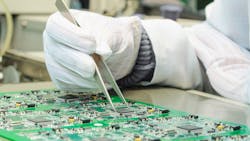6 Best Practices for a Smoother PCB Assembly Process
What you’ll learn:
- Best practices to follow for your next PCB assembly project.
- Helpful guidelines and instructions for robust PCB assembly.
Printed circuit boards (PCBs) are the foundation of every electronic device. However, for the PCB to work reliably, it’s imperative that a number of best practices are followed in their assembly. Follow these six steps to make sure your next PCB assembly process turns out a smoother one:
1. Proper communication
First, you need to ensure clear lines of communication with your PCB assembly partner—you of course don’t want to be in a position where your PCB is assembled without considering your needs. You must make sure that the PCB partner understands your bespoke requirements. Experienced partners also are equipped with industry best practices and will offer you important tips, whether it’s regarding improved techniques, the choice of material, the latest trends, or all of the above. In turn, this will ensure that you do not have to reinvent the wheel.
2. DFM check
One important way to ensure that your PCBs are error-free and work seamlessly is to run a design for manufacturing (DFM) test. The test identifies any errors in design at the early stages and avoids having to contend with costly errors as well as delays at a later stage. Issues such as spacing between components, component polarity, footprint corroboration, etc. can be identified well in time. In addition, the DFM test helps to:
- Reduce costs
- Speed up delivery as well as save time needed for rework
- Improve product quality
It’s important that the DFM test is performed by experienced, detail-oriented engineers.
3. Inspect the assembly material
The quality of components being used in the PCB is crucial. When you partner with a professional PCB assembler, you have the benefit of their quality-control department that evaluates the incoming material. Multiple factors—such as date code, and quality and model number to see if it matches with the BOM—need to be verified, and various tests be performed, including:
- Sample testing
- Check for deformation, oxidation, or any broken parts
- Material operational testing
4. Screening of SMT solder paste
Application of the solder paste is a very important aspect in the PCB assembly process. It’s typically done with a machine that holds the stencil over the board using a mechanical fixture. This is followed by an applicator applying the solder on the open spaces where the surface-mount (SMT) components are to be affixed.
It’s important to ensure that the composition of the solder paste is correct for the SMT assembly they’re putting together. After application of the solder paste, the engineers are required to inspect the board to ensure that the application is correct and it’s enough to hold the components.
5. X-ray inspection
One other best practice is to do an X-ray inspection to detect quality defects and other flaws after the reflow soldering process. This method is particularly useful for layered and complex PCBs. The X-ray process helps determine flaws such as:
- Faulty reflow profile
- Inadequate amount of solder paste
- Improper component placement and more
6. Final inspection
A professional PCB assembler will conduct robust inspections to ensure the PCBs are functional and error-free. At this stage, automated optical inspection (AOI) often is applied—it uses cameras to detect failures. AOI helps you scan through a large number of PCBs in a short time.
For small batches of PCBs, manual inspection also can be effective, although it requires lots of time and effort. Final inspection may include other tests as well, such as in-circuit testing and functional circuit testing.
Summing Up
Advanced technology has created better PCB tests to determine accuracy and reliability. Some of the best practices mentioned above ensure that the PCB assembly process becomes seamless. Importantly, the choice of a professional PCB assembler can make a significant difference when it comes to building quality PCBs.
About the Author
Ken Ghadia
Senior Sales Engineer, TechnoTronix
Ken works as Sales Engineer at Technotronix. He brings 15 years of experience in PCB sales and technical client services.
